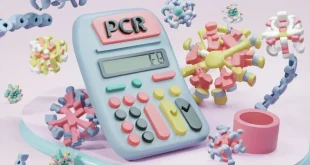Table of contents
Our Bacterial Growth Calculator is a handy and easy-to-use tool to help you understand and predict how fast bacteria can multiply under different conditions. This calculator is ideal for both students and professionals in biology, microbiology and ecology.
How does the calculator work?
You just need to enter the initial number of bacteria, their growth rate and the time over which you want to know their number. Our calculator will instantly calculate and show how the number of bacteria will change over a specified period. This is a great way to visualize how quickly microbial populations can increase.
Why is this calculator useful?
- Educational resource: Ideal for students and teachers wishing to demonstrate and study the dynamics of bacterial growth.
- Practical application: Useful for laboratory, health and environmental professionals to assess the growth of bacterial cultures.
- Ease of use: The simple interface makes it accessible to any user, regardless of their level of knowledge in the field of biology.
Explore the world of microbiology with our calculator
Use our bacteria growth calculator to learn more about the fascinating world of microorganisms and their impact on our lives and the environment. It's a simple yet powerful tool that will help you unlock the secrets of the microscopic world.
Instructions for using the bacteria growth calculator
Our Bacterial Growth Calculator is a handy tool to help you understand and predict the growth dynamics of bacterial populations. Here are simple step-by-step instructions on how to use it:
Initial bacterial count (N0):
- What it is: This is the number from which your observation or experiment begins. This is the number of bacteria you have at the beginning of time.
- How to fill: Enter a number indicating the initial number of bacteria. For example, if you start the experiment with 100 bacteria, enter 100.
Growth rate (r):
- What it is: The growth rate is the rate at which the number of bacteria increases. It may depend on many factors such as growing medium, temperature and other conditions.
- How to fill: Enter the growth rate value. This is a decimal number (for example, 0.5 means that each time interval the number of bacteria increases by 50%).
Time (t):
- What it is: This is the time period over which you want to calculate bacterial growth. Time can be expressed in hours, days or other units.
- How to fill: Specify the time over which you want to find out how the number of bacteria will change. For example, if you want to know how many there will be in 24 hours, enter 24.
Calculate:
- After you have filled in all the fields, click the “Calculate” button. The calculator will instantly display the result, showing how the number of bacteria will change over the period of time you specify.
Result:
- After clicking on the “Calculate” button, you will see how many bacteria there will be after the period of time you specify, based on the initial number and growth rate.
This calculator is a great tool for educational purposes, research, or even for curious minds wanting to learn more about microbiology. It is easy to use yet provides valuable information about bacterial growth dynamics.
Examples and calculations using the Bacteria Growth Calculator
Our bacteria growth calculator will help you understand how bacteria counts vary depending on the initial amount, growth rate, and time. Here are some examples to show you how to use this tool:
Example 1: Laboratory experiment
Task: In the laboratory you have a bacterial culture that starts with 200 bacteria. It is known that the growth rate of this crop is 0.3 (or 30%) per hour. You want to know how many bacteria there will be after 5 hours.
Solution:
- Initial number of bacteria (N0): 200
- Growth rate (r): 0.3
- Time(t): 5 hours
Calculation:
- Enter 200 in the Initial Bacteria Count field.
- Enter 0.3 in the Growth Rate field.
- Enter 5 in the Time field.
- Click "Calculate".
Result: The calculator will show how many bacteria there will be after 5 hours.
Example 2: Educational Example
Task: You are a biology teacher and want to show your students how quickly bacteria can grow. You start with one bacterium and assume a growth rate of 0.1 (or 10%) every hour. How many bacteria will there be after 24 hours?
Solution:
- Initial number of bacteria (N0): 1
- Growth rate (r): 0.1
- Time (t): 24 hours
Calculation:
- Enter 1 in the Initial Bacteria Count field.
- Enter 0.1 in the Growth Rate field.
- Enter 24 in the Time field.
- Click "Calculate".
Result: The calculator will show that the number of bacteria will increase significantly in 24 hours, showing exponential growth.
Example 3: Environmental monitoring
Task: Ecologists study a body of water where the initial number of bacteria is 5000. They estimate that the growth rate of bacteria in this environment is 0.2 (or 20%) per day. How many bacteria will there be after 3 days?
Solution:
- Initial number of bacteria (N0): 5000
- Growth rate (r): 0.2
- Time (t): 3 days
Calculation:
- Enter 5000 in the Initial Bacteria Count field.
- Enter 0.2 in the Growth Rate field.
- Enter 3 in the Time field.
- Click "Calculate".
Result: The calculator will show how the number of bacteria in the pond will change over 3 days.
These examples show how the calculator can be used for a variety of purposes, from laboratory research to educational demonstrations to environmental monitoring. The calculator makes calculations simple and straightforward, making it a valuable tool in many areas.
 SAS tools Website with 1000s of useful SAS tools and calculators
SAS tools Website with 1000s of useful SAS tools and calculators 